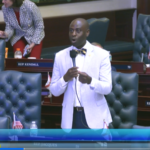Jonathan Phillips says he thinks about Louisiana’s disappearing coastline every day.
As a commercial fisherman and member of the Atakapa-Ishak/Chawasha tribe, he sees water levels rising in Plaquemines Parish firsthand. He grew up in Marrero but spent a lot of time as a child in Grand Bayou Indian Village, a small community in south Plaquemines Parish that is being threatened by the effects of climate change — rising sea levels, more intense tropical storms and land loss. With the erosion of barrier islands — which protect wetlands from storm surge and saltwater intrusion — life on the bayou is getting more precarious, said Phillips, whose parents moved back to the village after raising him in Marrero.
As “soon as the tide got high you see the marsh floating away,” Phillips told Verite News, referring to Hurricane Francine, which struck southeast Louisiana last month. “Next strong storm will come and take it all away.”
Communities like Grand Bayou, located outside the federal levee system, are increasingly vulnerable to storms as the shoreline recedes.
Over the past 60 years, the land-to-water ratio in Grand Bayou has been steadily decreasing, according to the University of New Orleans study. In 1968, there was more than twice as much land than there was water; now the village is mostly water. The church, Evening Light Tabernacle, and the houses that make up the village are only accessible by boat. It has suffered one of the highest rates of land loss on the state’s coastline, based on a 2011 study published in the Journal of Coastal Research.
Phillips, who still lives in Marrero but continues to visit the village often, said the Grand Bayou is his “paradise.” Still, the village has changed since he was a child — the land used to be higher and the marsh grass didn’t grow so close to houses. As time passed and land loss made storms more devastating, many people moved away from the village, including John’s family.
“It’s hard to live here and lose everything,” Phillips said. “Take a chance of losing everything every year. So, you’re kind of forced to… move away.”
Now, in order to protect the community from the effects of land loss, the tribe is partnering with the Coalition to Restore Coastal Louisiana, an environmental nonprofit, to bring life back to the area by building reefs out of recycled oyster shells throughout the village.
Over four days in September, volunteers with the coalition constructed oyster reefs to protect areas that would otherwise be impacted by erosion from high tides and storms.
Rosina Philippe, a council elder and a traditional knowledge holder for the tribe who works on coastal restoration in the area, was at the second day of the reef building project. She said that growing up in the village was idyllic.
“Everything that we needed was here,” she said.
But with the fracturing and disappearance of the marshland, Grand Bayou has lost much of what once made life possible.
For many years, members of the tribe lived independently, surviving off the land and finding sustenance through small-scale farming, fishing and bartering. In the past five to six years, they have grown more dependent on grocery stores because land erosion and saltwater intrusion have made growing crops and raising livestock more difficult. With high levels of salt in the remaining land, dead trees aren’t an uncommon sight in the bayou. Philippe attributes the lack of animal life, especially birds, to the loss of the marshlands.
“We’re losing habitat,” Philippe said. “We’re losing rookeries. There are other life forms that depend on this place, and people tend to forget that.”
Restoring habitats
Oyster shells recycled by New Orleans and Baton Rouge restaurants were sent to the village in mid-September. From there, volunteers loaded bags of shells onto boats and placed them along the shoreline to protect homes and navigational areas.
The shells will support the growth of new oysters, which filter water and are considered a keystone species because of the thriving marine community they help create. Fish and crabs use the reefs that oysters create as nurseries. When living oysters grow on them, snails and other predators come to feed. The restoration of this marine habitat may provide commercial benefits for residents.
Philippe said that these kinds of low-tech and relatively inexpensive solutions have high success rates. The Coalition to Restore Coastal Louisiana said other reefs it has built have reduced shoreline erosion by up to 50%.
Some of the reef was built around Carmelita Sylve’s property. Sylvie is a lifelong resident of Grand Bayou and, like Phillips, is afraid that her home, community and way of life will be lost to the water.
“(There’s) a lot of waterway, and the land is disappearing,” Sylvie said. “I’m so thankful for CRCL, that has come out here to bring these shells to put around our properties so that it can — can’t maybe stop the erosion, but at least maybe slow it down.”
The coalition has been working with the tribe since 2019. Their first project together was in 2022, when the tribe and coalition attempted to protect Lemon Tree Mound, a formerly elevated area built by Indigenous people. It is a sacred site to the Atakapa-Ishak/Chawasha, a place where people once brought offerings to their ancestors. Two years after a reef was built around the mound, aquatic life such as snails, crabs and oysters has returned to it.
On Sept. 20, the land of Lemon Tree Mound was returned to the tribe by St. Paul’s Episcopal Church, which had acquired it through a 1991 donation as a part of a trust.
In a speech to the tribe and coalition volunteers, the Rev. Marian D. Fortner, of St. Paul’s, said she felt compelled to return to the land when she found out it was sacred to the Atakapa-Ishak/Chawasha. She said its cultural significance was “all the more reason to entrust it back, to give it back to the mother who cares for it.” In a show of thanks, the tribe gave the church a handmade blanket.
Philippe said she hopes the rematriation of the site will start a trend to return the land to its Indigenous stewards while fostering solidarity between the tribe and non-Indigenous people.
Future threats from LNG
Philippe’s hope is tempered by worry from a looming threat just down the road from the village. Venture Global LNG is building a liquified natural gas production and export facility in Port Sulphur, which is approximately 12 miles from the village.
LNG facilities have been found to pollute communities with potentially deadly chemicals like carbon monoxide and cancer-causing molecules like sulfur dioxide, according to the Environmental Integrity Project. Often, construction of LNG facilities leads to the destruction of marshland, contributing to land loss that was exacerbated by the initial digging and fossil fuel extraction practices from the last century in those same wetlands.
Al Duvernay, a Metairie resident and volunteer who helped with the reef build, said that he has hunted and fished in the waters of Grand Bayou since he was a child. He said watching the destruction of the marshland in front of his eyes was “devastating” and “heartbreaking.”
“I’ve watched the oil companies dredge their canals,” Duvernay said. “I mean, literally, sitting in a duck line with my dad and the dredges are going through the marsh, tearing up the marsh.”
The Plaquemines LNG terminal would destroy hundreds of acres of wetlands, according to the Federal Energy Regulatory Commission’s assessment. But the agency concluded that Venture Global LNG has taken measures to mitigate wetland degradation and that impacts on the surrounding water and wetlands will not be significant. Still, environmental groups have been critical of the project, saying that the levees have design flaws that may not prevent flooding during major storms and could cause “catastrophic damage” to the surrounding areas. Verite News reached out to Venture Global LNG, but the company didn’t respond to requests for comment.
Philippe called the LNG terminal a “monstrosity.” She is worried about the negative environmental effects the plant may have for generations to come.
Other tribe members, like Phillips, said that oil companies and the state bypass the community and don’t listen to their concerns. He said that fighting the oil company is “fighting a losing battle.” Still, he has hope for the community’s survival.
“We learn to adapt,” Phillips said. “We’re gonna survive. That’s one thing about a commercial fisherman and somebody from Grand Bayou. We will adapt. We will survive out here. This is our land.”
Was this article valuable?
Here are more articles you may enjoy.


 Did Florida House ‘Sneak’ Attorney Fee Wording Into Phosphate Mine Bill?
Did Florida House ‘Sneak’ Attorney Fee Wording Into Phosphate Mine Bill?  State Farm Wins Dismissal of Class Action Over Xactimate Software
State Farm Wins Dismissal of Class Action Over Xactimate Software  Global Q1 Commercial Insurance Rates Drop 3%, but US Casualty Bucks the Trend
Global Q1 Commercial Insurance Rates Drop 3%, but US Casualty Bucks the Trend  Class Action Accuses Toyota of Illegally Sharing Drivers’ Data With Progressive
Class Action Accuses Toyota of Illegally Sharing Drivers’ Data With Progressive 

